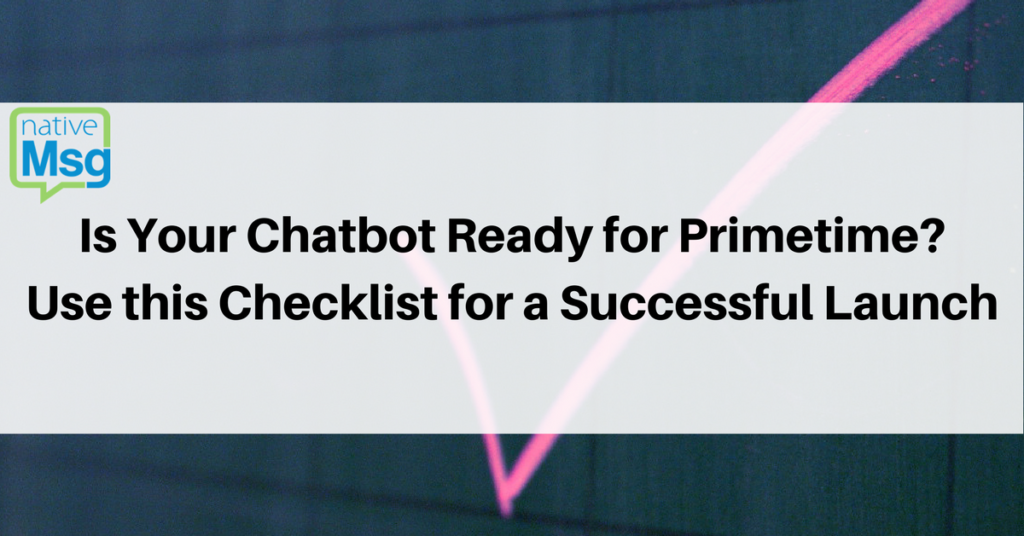
What do Microsoft’s Tay, Humanoid robot “Sophia” and Facebook’s “M” have in common? They’ve all gotten (digital) egg on their face at some point and flubbed––badly.
While the tech world winced and the media world grimaced, the business world has continued to invest in AI, with one forecast set at about $1.2b invested in the chatbot market by 2025. This level of investment stamps out any lingering idea that chatbots are a fleeting, limited tool.
But that doesn’t help businesses today, that are continuing to question how to proceed successfully with chatbots for business, when even big tech has taken a (seeming) lemon…into the limelight?
First, this is the upside of being a mid-range adopter. The timing creates a great opportunity to clarify better practices and shape a launch with better results.
Also, if you have no idea about how to get started with chatbots, you can begin here: What is a Chatbot? A Simple Guide and Trends for 2018.
You may already know you want an AI customer service bot, integrated within IoT devices, as a conversational knowledge base, or to embed one directly onsite for AI customer engagement and lead-building. (You can go here for the low-down on conversational websites.) But it’s likely you have many questions about each phase––design, delivery and launch––to make sure your chatbot is truly customer-ready.
Here’s what you need to cover to make sure your chatbot is ready to introduce to customers.
√ Have we used all customer conversation analytics data that’s available?
Design with Thorough Data:
Listen to your customers. Use every channel that your customers interact on and gather all the data available. Great chatbot experiences include this kind of thorough digging.
The Strongest User Incentive Creates the Best Use-Case
Data channels can include:
- FAQ interaction
- All social media interactions and comments
- All customer inquiries and interactions within email, text, phone and mail
You’ll be better positioned to design a chatbot that answers more common inquiries, and to know what types of responses to program based on the patterns you’ve gleaned from conversation analysis. You can then drive an experience using insights from how customers think about your brand, the concerns they have, the problems they want to solve and how they talk about all of the above.
√ Have we tested and iterated for all conversation variants within the scope of the application?
Plan, Plan (and Plan)-Focus on Tight Design:

Research shows that the more specific your chatbot’s application, the more successful it will be.
But that might not be for the reason you think. Chatbot technology, which includes machine learning and deep learning, is advancing rapidly. Some limits that existed even six months ago are no longer obstacles. Some models can now even learn without data, and an increasing number of developers are creating new machine learning models. However, to achieve this level of sophistication, it takes resource, the right team and the right budget, which brands must commit to in order to be successful.
Certainly, it’s not a bad strategy to implement a chatbot sooner than later, even if solely on Facebook Messenger, to increase responsiveness and service. A well-defined application to start can garner, in some cases, over 50% less churn, gather 50+ leads in a week and create higher sales rates, faster.
There are three types of chatbots, per Stanford. You can create a rule-based chatbot, a chatbot that retrieves information or one that grows through transduction learning. This is a way of designing a chatbot so that machine learning is based on known sets of information and can make predictions based on these.
Rule-based models are easy for almost anyone to make. But the more complex a question, the more difficult it can be for a chatbot. You don’t need to know every machine learning algorithm, but you should understand that the right algorithm(s) garner better results. Taking time within this step is crucial.
Ensure your chatbot is on the right track in functionality and correct responsiveness:
- Is there response variation? Identify what areas in the conversation elicit similar responses and write and design to these variations.
- Are conditional responses properly designed? In a dialogue tree design, the simplest form of a chatbot flow, an experience should begin generally and advance to more specific conditions. Since more advanced chatbots can have multi-variant conditions, meaning, there’s more than one topic you can address along with conditions for each of these, a well-designed flow ensures your chatbot accounts for every keyword condition and flows properly to each.
- Identify where loop errors could (and do) crop up. This is where design meets execution, and it’s the touchstone of thorough planning. But, this is also why a simple-use chatbot, to start, is a good way to ensure better user experience. Remember, you can always make updates. That’s the benefit of an always-on, always learning application like conversational AI.
√ Does our chatbot include only media that’s necessary to propel the conversation, and is the conversation well-paced?
Create Realistic Conversation Variation:
One of the key guidelines of design is: Just because you can, doesn’t mean you should. Like a good story or screenplay, every conversation and every tool you use to guide it must serve to advance the conversation.
- If it throws off your pacing, take it out. A cool meme isn’t cool when it takes a while to load. Keep a focus on pacing throughout a conversation. You might think pacing works when you first design it, but give your team time to review it. Time will reveal that what seems to work on the outset needs tweaking.
- Likewise, mirroring customer conversation patterns, or syntax, in chatbot copy is a simple way to engender both customer trust and user engagement.
- Copy must marry use-case––almost formulaically. A retail chatbot wouldn’t make small talk in the first few steps, but a voice assistant that schedules travel might.
√ Do we have internal buy-in that successful chatbots require data-training and that both marketing and copy need to reflect this?
Set Expectations Internally, to Set Realistic User Expectations:
There is one public expectation that’s challenging to overcoming, and if you can address this hurdle within marketing communication, you’re better positioned for a successful launch. That is, a chatbot should be fully capable and perfect upon launch. It does seem counterintuitive to launch a product that needs work! But this isn’t what’s really occurring when you launch a well-built, expertly designed chatbot.
Internally, your team and stakeholders need to agree that a chatbot launch is a new and unique approach that has to address response variants as a necessary part of data training, despite that this is done publicly. Instead, it needs to be thought of as normative, but within reason. As an example, humanoid Sophia has made some public missteps, but these haven’t been fatal.
- Intelligent chatbots learn through crowdsourcing for corrective growth. This is in direct conflict with the idea that users want a perfect experience. In reality, users want responsiveness and faster service, so there’s some room for growth if the first two needs are well-met.
- Keep your users educated that when they reply, the chatbot grows and learns.
- Users will become more comfortable with the idea of “data training within reason,” if there’s also a design element that fast-tracks users to simple search results for their main query.
- Successful chatbots, like many celebrity chatbots, serve such a strong purpose that fans are fine with the simplicity and the fact that these are bots. Instead, chatbots have been a perfect way to create personalization and access.
Chatbots do have room to grow. But if you follow these best practices you’ll position your chatbot for higher success rates. You’ll have created one more avenue of thoughtful service and your customer and users will appreciate it with higher engagement and loyalty.
Learn how your brand can integrate an intelligent chatbot into customer service strategy with nativeMsg.
Free Trial
Get Started With RCS
Business Messaging!
Unlock the power of RCS and revolutionize your customer engagement.


